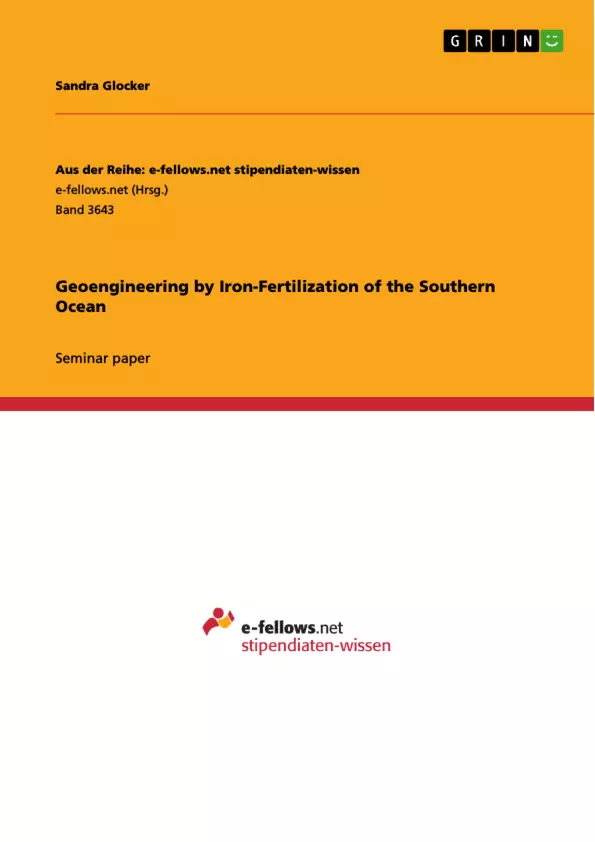In order to keep global warming below 2°C, the use of geoengineering is being considered. Geoengineering is a human large-scale, long-term intervention in natural cycles with the goal to mitigate global warming. One broadly discussed way of extracting CO2 from the atmosphere is iron-fertilization of the ocean, in particular the Southern Ocean. This essay will examine the ocean as a natural carbon dioxide sink and how it could be utilized by this geoengineering method. Some practicalities and risks are looked at and evaluated to come to the conclusion that iron-fertilization of the Southern Ocean could mitigate rising CO2 levels. Nevertheless, we should not do it, because the potential benefits of the technology do not weigh up its risks for the ecosystem.
Inhaltsverzeichnis (Table of Contents)
- A. Aiming for less than 2°C Global Warming
- B. Scientific Evidence
- I. The Ocean as a Carbon Dioxide Sink
- II. Principle of Iron-Fertilization
- III. Appropriateness as Commercial Carbon Sequestration
- 1. Potential
- 2. Cost
- 3. Legal Basis
- 4. Risks
- C. Discussion
- D. Conclusion
Zielsetzung und Themenschwerpunkte (Objectives and Key Themes)
This essay examines the potential of iron-fertilization of the Southern Ocean as a geoengineering method to mitigate rising CO2 levels. It explores the ocean's role as a carbon dioxide sink and investigates the feasibility of this technology by analyzing its practicalities and risks.
- Geoengineering and the role of the Southern Ocean as a carbon sink
- Iron-fertilization as a method for carbon sequestration
- The potential benefits and limitations of iron-fertilization
- The legal and ethical implications of large-scale geoengineering
- The risks associated with iron-fertilization and its impact on the ecosystem
Zusammenfassung der Kapitel (Chapter Summaries)
The essay begins by outlining the urgent need for reducing global warming below 2°C and introduces the concept of geoengineering as a potential solution. The focus then shifts to the ocean's role as a carbon dioxide sink, explaining how phytoplankton absorb CO2 during photosynthesis. The process of iron-fertilization is introduced as a method to enhance this natural process, by stimulating phytoplankton blooms in iron-limited regions like the Southern Ocean.
Chapter B further explores the scientific evidence behind iron-fertilization, discussing its effectiveness in stimulating phytoplankton growth and the challenges associated with its implementation. The chapter examines the potential for iron-fertilization to sequester carbon in the deep ocean and the limitations of this method, including the possibility of nutrient loss and recycling.
Chapter C delves into the appropriateness of commercial carbon sequestration through iron-fertilization. It discusses the potential for this method to remove significant amounts of carbon from the atmosphere, as well as the costs involved, legal implications, and the associated risks to the marine ecosystem.
Schlüsselwörter (Keywords)
Geoengineering, iron-fertilization, Southern Ocean, carbon dioxide sink, phytoplankton, carbon sequestration, climate change, global warming, ecosystem, risks, benefits, legal implications, commercial carbon market.
- Arbeit zitieren
- Sandra Glocker (Autor:in), 2020, Geoengineering by Iron-Fertilization of the Southern Ocean, München, GRIN Verlag, https://www.grin.com/document/908764



